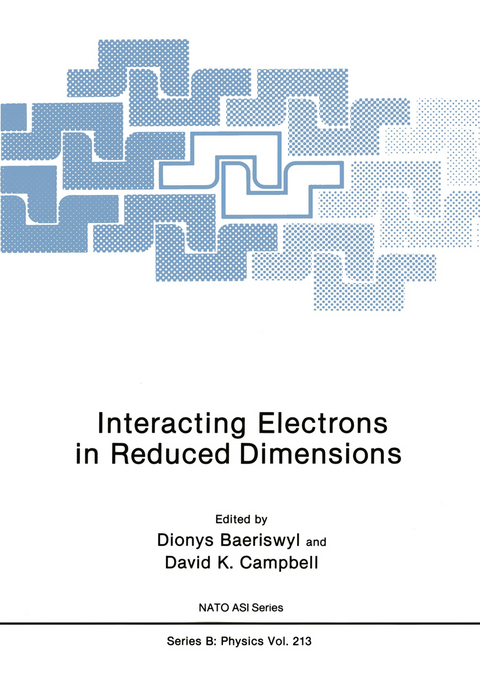
Interacting Electrons in Reduced Dimensions
Kluwer Academic / Plenum Publishers (Verlag)
9780306434150 (ISBN)
- Titel z.Zt. nicht lieferbar
- Versandkostenfrei
- Auch auf Rechnung
- Artikel merken
I. Methods.- A. Solvable Models and Analytic Results.- Brief History of a One-Dimensional Ground State Wave Function.- Two Theorems on the Hubbard Model.- A Model of Crystallization: A Variation on the Hubbard Model.- The Fermi-Linearized Hubbard Model: Dimer Ground State.- Superconductivity of Itinerant Electrons Coupled to Spin Chains.- Valence Bond Spin Models: Ground States and Excitations.- B. Quantum Monte Carlo and Numerical Diagonalization Methods.- Numerical Simulation of the Two Dimensional Hubbard Model.- Stable Matrix-Multiplication Algorithms for Low Temperature Numerical Simulations of Fermions.- Numerical Simulations of the Two-Dimensional Hubbard Model.- Monte Carlo Simulation of a Three-Band Model for High-Tc Superconductors.- Exact Valence-Bond Approach to Quantum Cell Models.- Lanczos Diagonalizations of the 1-D Peierls-Hubbard Model.- C. Variational and Perturbation Theoretic Methods.- Variational Wave Functions for Correlated Lattice Fermions.- Variational Approach to Correlation Functions and to the Periodic Anderson Model in Infinite Dimensions.- The Hubbard Model in Infinite Dimensions.- Correlation Functions for the Two-Dimensional Hubbard Model.- D. Density Functional Theory.- Density Functional Calculations for Strongly Correlated Systems.- Dimensionality Effects in trans-(CH)
x.- II. Quasi-One Dimensional Models and Materials.- A. Applicability of Hubbard-Type Models.- The Hubbard Model for One-Dimensional Solids.- Off-Diagonal Coulomb Interactions in the Extended Peierls-Hubbard Model: Exact Diagonalization Results.- Electron Correlation and Peierls Instability.- B. Organic Conductors and Conjugated Polymers.- Instabilities in Half-Filled One-Dimensional Systems: Valence Bond Analysis.- Quantum Monte Carlo Study of Neutral-Ionic Transition.-Diagonal and Off-Diagonal Electronic Interactions and Phonon Dynamics in an Extended Model of Polyacetylene.- Phonons and Quantum Fluctuations in a Dimerized Electron-Phonon Chain.- Scaling Approach to Electronic Correlations in Organic Conductors.- Peierls Instability in Weakly Non-Ideal One-Dimensional Systems.- Use of the Spin Hamiltonian to Study the Spin-Peierls Instability and Magnetism in Conjugated Polymers.- A Two Band Model for Halogen-Bridged Transition Metal Linear Chain Complexes.- Numerical Simulation of a One Dimensional Two Band Model.- Disordered Quantum Spin Chain and its Relevance to the Disordered Superconductor.- 1/n Expansion for Quantum Heisenberg Antiferromagnets.- III. Quasi-Two Dimensional Models and Materials.- Fractional Quantum Hall Effect: Recent Developments.- Fröhlich Conduction of Spin Density Waves in Quasi-Two Dimensional Systems.- A Unified Theoretical Approach to Superconductors with Strong Coulomb Correlations: The Organics, LiTi2O4, Electron- and Hole-Doped Copper Oxides and Doped BaBiO3.- Spin Fluctuations and Quasiparticles in Cu-O Planes.- Electronic Properties and Spin-Correlations of CuO2-Planes in High Temperature Superconductors.- Numerical Approach to Magnetic Mechanism of Superconductivity.- Parastatistics for Highly Correlated Two Dimensional Fermi Systems.- Composite vs Constituent Particle Aspects of Hole Motion in the CuO2 Plane.- S Pairing by Double Excitation of Triplet in Two Band System with Intermediate Electron Correlations.- Fermi Liquid Theory for High Temperature Superconductors.
| Erscheint lt. Verlag | 31.10.1990 |
|---|---|
| Reihe/Serie | NATO Science Series: B ; 213 |
| Zusatzinfo | 414 p. |
| Verlagsort | Dordrecht |
| Sprache | englisch |
| Themenwelt | Naturwissenschaften ► Physik / Astronomie ► Atom- / Kern- / Molekularphysik |
| ISBN-13 | 9780306434150 / 9780306434150 |
| Zustand | Neuware |
| Informationen gemäß Produktsicherheitsverordnung (GPSR) | |
| Haben Sie eine Frage zum Produkt? |
aus dem Bereich


